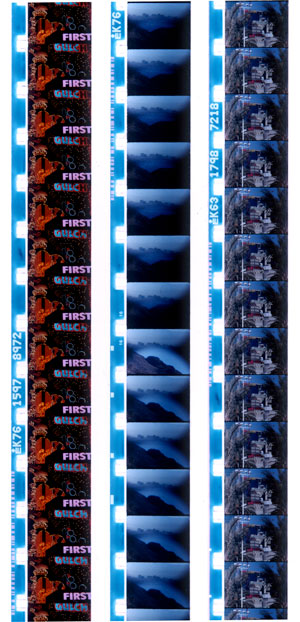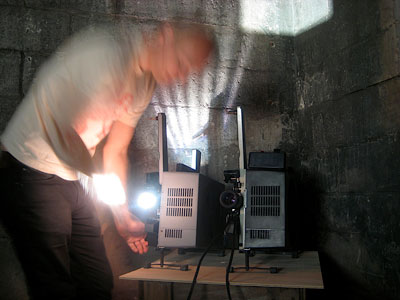Performative Projections
 by Brandon Kosters
by Brandon Kosters
On September 11, SAIC’s Eye and Ear Clinic hosted “Films for One to Eight Projectors,” a collection of multi-projector short films by Roger Warren Beebe. Beebe challenges the notion of film as a stagnant medium by manipulating multiple projectors in real time. The event took place at the Flaxman Theater.
Beebe, a film and media professor at the University of Florida, was propelled to approach film in a more performative way in part because he wanted a more active role in presenting his work.
Manipulating film projectors in real time became a means of “justifying my presence. It expanded the repertoire … [the screening] became something you could only see with me there.
I guess percolating in the background was the knowledge that this kind of thing had happened before … the great cinematic tricks and gimmicks of early cinema and pre-cinema. This informed my experimentation. I was doing tours and started to question the necessity of my presence.”
Throughout the course of the screening, Beebe was wandering about the room, handling the projectors and the devices that were providing the audio. The way that Beebe utilizes audio also lends itself to spontaneity.
“One of the things about the films that’s made the interplay of the sound and image more critical is that I’ve stopped making married prints.” The audio is not connected to the films themselves. “I have different sound devices that I run into my mixing board every night to synch up with the film. There is more malleability in terms of the sound and image than if the two are linked in.”
His film TB TX Dance utilizes two video projectors, with two practically identical black and white films shown juxtaposed. The color scheme is inverted. The film features the shape of the state of Texas, images of a dancing woman, and dots that were printed directly onto clear film leader with a laser printer. The dots also serve as an optical sound track, with the frequency of the pitch corresponding to the density of the dots.
 “Another one of these gimmicks (or, expansions of the normal practice),” Beebe says, “is a karaoke accompaniment.” For this screening for SAIC, he recruited SAIC alum William Amaya to fill in. Amaya offered his take on the vocals for the Mudhoney song “Touch Me, I’m Sick,” with the lyrics projected over an educational film from the 1970s about syphilis.
“Another one of these gimmicks (or, expansions of the normal practice),” Beebe says, “is a karaoke accompaniment.” For this screening for SAIC, he recruited SAIC alum William Amaya to fill in. Amaya offered his take on the vocals for the Mudhoney song “Touch Me, I’m Sick,” with the lyrics projected over an educational film from the 1970s about syphilis.
The final piece in the screening was Last Light of a Dying Star, which consists of eight films projected simultaneously.
“The eight projector show was made for a screening at a planetarium in Georgia. With this piece I am almost like an orchestra conductor with these elements. I created a lot of the material, but I am also reliant upon these people’s works … people who contributed directly and all of these anonymous industrial filmmakers [whose work is appropriated].”
“From an audience perspective, almost every audience is composed of people who’ve never seen it before. For me, in the coordination of elements, things change. I mix it around a little bit, which loops are in which projector. I have to adapt [the piece] to each space. In Bloomington, the grid was as elegant as it has been, but the strongest ending was in Atlanta. It always ends up being the same length: 23 to 27 minutes. I wouldn’t say it varies wildly. I’m the only one who probably knows, as I’m the only one with a basis for comparison. There are always surprises that lead to really cool things. It’s like a band that plays their songs every night. The performers themselves are in the best place to recognize these differences.”
According to Beebe, “The film attempts to recapture some of the excitement of the early days of space exploration and the utopian aspirations of expanded cinema. Made as an orchestration of a number of different elements, made and found: handmade camera-less film loops by [myself] and Jodie Mack; striking sequences of digital stills by Cassandra C. Jones; 16mm educational films about eclipses, asteroids, comets, and meteorites; and a super-8 print of the East German animated film The Drunk Sun.”
Beebe considers his work accessible. And how does his work differ from more commercial vehicles in his opinion? “I think with the eight-projector piece, it’s a slowing down rather than a speeding up. It’s immersive. One difference is that with my piece, there is nothing to sell. I tried to document the eight-projector piece, and it didn’t work. There was the rectangle, with eight little rectangles within it. I see it as a philosophical thrust in a different direction.”
Music and sound play a prominent role in Beebe’s work. Beebe himself worked as a musician at one time, and co-edited the book Medium Cool: Music Videos from Soundies to Cellphones, about trends in the music video industry that can be attributed to sites like YouTube. However, he maintains that for his practice, the image itself must take precedence over sound. “[With music videos] it’s an impoverishment. Even the best videos are reliant upon the song. It flattens the video. I like music as an element in the films. I don’t ever want to get to a point where the music is foregrounded to the point of flattening of the complexities of the image. There are places where I want the sound to recede to allow the image to breath, or lead.”






